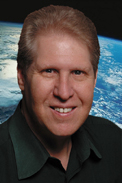Once
the sole province of cable service providers, l,ocal
digital ad insertion rapidly is gaining traction among
broadcasters. The trend will increase with the conversion
from analog to digital broadcasting.
"The big megatrend
in advertising insertion is addressability, the
personalization of one-on-one targeted commercials," said
Kanaiya Vasani, VP of marketing and product management
for Terayon in Santa Clara, Calif. This already is being
done successfully on the Internet, and the next focus is
broadcast television.
"We're seeing
addressability manifest through a phased approach," he
said. Network broadcasters traditionally have fed one ad
to a mass population, "yet the next phase is
'localization' of national ads at the affiliate level,"
like inserting an ad for a Ford Explorer SUV in Denver
while inserting an ad for a Ford Escape hybrid in
Baltimore.
Terrestrial and
satellite broadcasters transmitting point-to-multipoint
face real architectural hurdles to delivering
personalized advertising, he said, but addressability is
easier for point-to-point services like cable and
Internet protocol television (IPTV) over phone
lines.
"The business
motivation for digital ad insertion is to increase
profits," said Yaron Simler, President of Scopus Video
Networks, an Israeli company based in Princeton, New
Jersey. Cable operators like Comcast and Cox have
accepted the research that viewers feel few ads are
relevant to them, so they turn their attention away
during commercials or they skip over the ads with digital
video recorders.
"When you split the
target area for an ad with localized or zone insertion,"
Simler said, "since you are selling multiple spots for
that same 30-second time slot, you can make ads more
affordable to local businesses. Targeted ads are watched
more, which merits a higher CPM ad rate, so you are able
to generate more overall ad revenues."
"Localization is
why cable operators in the U.S. have wholeheartedly
adopted digital ad insertion in the last 24 months as a
significant source of revenue," said Sharar Bar, Director
of Satellite and Broadcast for Harmonic Inc., based in
Sunnyvale, Calif. The national cable networks are opening
multiple advertising "avails" to insert regional or local
commercials from local server hubs, he explained.
"Terrestrial
broadcasters will continue doing analog ad insertions in
the short to medium time frame," Bar said, "but I expect
broadcasters will move into digital ad insertion over the
next 24 months."
"The first thing
most network studios invest in when they switch to
digital is a file server," said Paul Turner, VP of
product marketing for Omneon Video Networks in Sunnyvale,
Calif. "And in almost every case the new server is for ad
insertion."
Turner said initial
server purchases tends to be on the low end because the
video clips for ads are small compared to the file server
requirements of full programs. "It's a logical move for
our customers to take that approach."
At the same time,
he observed, "the broadcast companies are getting more
sophisticated with their general ad presentations, such
as TV stations inserting spots in multiple languages,
like English and Spanish, which is something we're seeing
with South American broadcasters."
Volume
Levels
A challenging issue
in this process is different audio volume levels in
inserted and regular content, said Jeffrey Miller, Senior
Broadcast Product Manager at Dolby in San Francisco.
"Analog ad
inserters used brute force tech features to keep levels
under control, such as auto gain control circuits. We no
longer have that in the digital world, so it's important
to create all local spots at the same level as the
national content."
One solution is to
create metadata that ensures all digital audio plays back
at the same level on the set-top box. Dolby is working on
this approach in an industry group that includes the
Society for Cable Telecommunications Engineers (SCTE),
CableLabs, cable system operators, content networks, plus
manufacturers of file servers and splicing
equipment.
"Doldy years ago
developed a digital loudness meter, the LM 100, that
helps those at local systems who ingest content without
having a lot of technical audio experience, he said. To
make it even easier for them, Dobly recently introduced
the DP 600 digital processor, which offers automated
hands off loudness control
Miller said
broadcasters have not put as much effort into local audio
levels as the cable industry, but that's changing as ATSC
content is deployed more widely.
Analog broadcast
networks like NBC and cable networks like HBO have relied
on audible cue tones to mark where local ads should be
inserted, said Mark Corl, Senior Director of systems and
architecture at Trevini Digital in Princeton, New Jersey.
Treveni can convert analog cue tones to digital for cable
operators, he said, "but this is a stop-gap measure."
The real solution,
he said, is embedding digital cues within the content
from the start. One such option for broadcasters involves
the Tube Network, an MTV-type music service out of
Atlanta that broadcasters can offer on their secondary
DTV channel. The Tube Network is using a Digital
Turnaround Processor (DTP) from Harris that does digital
ad insertion splicing. Trevini supplies the digital cues,
he said, and Tandberg supplies the encoder.
"The huge thing
that's happened technologically to enable the shift to
digital insertion is the development of insertion
standards," said Jean Macher, Director of Marketing
Networks Solutions for Grass Valley, a business within
Thomson based in Beaverton, Oregon.
Leading this effort
was SCTE, which developed the SCTE30 and SCTE35 standards
for signaling and triggering ad insertions within the
digital content stream for cable and IPTV.
"The SCTE30/35
standards enable frame-accurate transitions within the
video and audio feed," Macher said. The key is an advance
trigger message embedded within the digital signal that
carries timing information for the exact frame where
content should be inserted. This is the technology
incorporated into Grass Valley's new Sapphire MPEG-2
video servers that support standard definition and high
definition ATSC datastreams.
"When you can sync
digital audio and video with a standard time stamp that
matches content insertion to a particular frame," he
explained, "you no longer need to decode the compressed
signal to splice in the insertion and then encode it
again."
SCTE Standards
The SCTE 30/
standards also support the new cable-centric AdPulse On
Demand Advertising System for video-on-demand (VOD)
applications from SeaChange International, headquartered
in Acton, Mass. Broadcasters also can benefit from the
system, according to James Kelso, VP of Marketing and
Communications.
Cable operators are
moving all channels into the digital tier, Kelso said, so
broadcasters' local SDTV and HDTV channels can play
cleanly through cable's digital set-top boxes. "This
opens opportunities for broadcasters and cable to enjoy a
robust business together."
Cable operators are
subdividing their plants to control content in the last
mile and deliver targeted ad insertion, both localized
and personalized. " Local broadcasters can work with
cable operators to use their time slots in local news,
sports or cooking shows to insert sticky localized or
personalized ads. If broadcasters can make their ads
better fit their viewers, they can get more eyeballs for
these ads, and that means more revenue from these
ads."
"Everything is
moving to an on-demand environment in the cable world,"
said Reed Barker. Group Product Director for content and
advertising at Tandberg Television, the Norwegian company
with corporate offices in New York City. "You now need to
see beyond a national 30-second or 60-second spot in a
scheduled place and time, like in the Super Bowl. You
need to start thinking about new business models for
inserting targeted ads within on-demand programming and
even within video podcast downloads.
He suggests
thinking of ad time like shelf space in a supermarket
where some products are displayed on the row with similar
products and other products are spotlighted in end caps.
For instance, digital servers could insert a spinning
Coke logo at the corner of a screen as a graphical
overlay, or an ad for a movie could contain inserted data
on where the movie is playing locally, perhaps with an
active hyperlink that says, "Buy tickets now!"
"We're moving away
from appointment TV with all programming and advertising
scheduled by the networks," Barker said. "Ad insertion
must reflect the shift to an on-demand world." 
.















